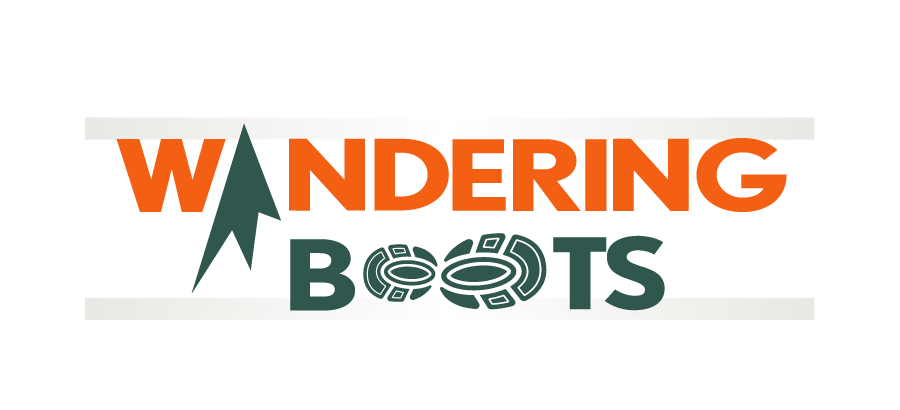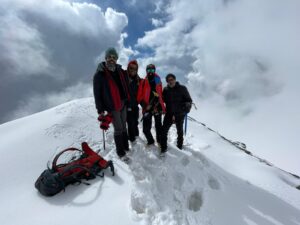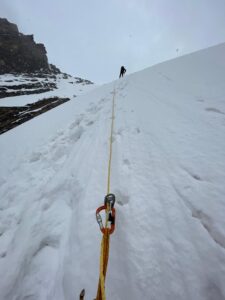- Overview
- Trip Outline
- Trip Inclusions
- Trip Exclusions
- Gallery
- Reviews
- Book Now
- FAQ
About the peak
Explore the majestic Mt. Deo Tibba, standing at 6,001 meters in Himachal Pradesh’s Kullu Valley. Known as the assembly point for gods, this peak offers a challenging mountaineering experience with vertical ice gullies and an ice cap en route. The journey begins in Manali and leads through stunning meadows, rocky landscapes, and snow-covered terrain. Conquer the daunting slope to Duhangan Col and marvel at the unique dome-shaped summit. This expedition demands technical expertise and is ideal for experienced mountaineers. Join us for an unforgettable adventure to the heights of Mt. Deo Tibba.
The Summit climb of this peak is a technical climb where the climbers would be required to wear Crampons and will be using ropes.
We will give you a demo on rope systems on previous days to get you accustomed to the technique.
The Area
The Manali peak trek begins from Jagatsukh, which is around 5 kms from Manali in the Kullu valley. The Kullu valley is a prime tourist and adventure destination. Its unparalleled beauty along with easy accessibility has attracted many adventurists. No wonder some call it the Chamonix of India.
Expected Weather
- Chances of rain/ hail – Less
- Chances of snowfall– Less
- Temperatures
Days: 12 to 15 degrees celsius. Nights: Around -5 degrees celsius at higher camps
Day 1: Arrive in Manali
You will meet our climbing expert, who will brief you about the expedition. Practice rope systems in the evening.
Overnight at homestay in Manali
Day 2: Drive to AD Hydro Project Tunnel Point. Trek to Chikka (3350 mts)
Trek distance: 3 kms, Trek time: 3 hrs
Overnight stay in camps
Day 3: Trek from Chikka to Seri (3600m)
Trek distance: 6 kms, Trek time: 5 hrs
Overnight stay in camps
Day 4: Trek from Seri to Chandertaal Lake (Deo Tibba Base Camp)(4480m)
Trek distance: 8 kms, Trek time: 7 hrs
Overnight stay in camps
Day 5: Acclimatization day at base camp
Overnight stay in camps
Day 6: Move camp to Col Camp (5000 mts approx) via Tentu galli. Technical climbing day
Trek distance: 2.5 kms, Trek time: 3 hrs
Overnight stay in camps
Day 7: Acclimatization hike to Norbu peak (5226 mts)
Trek distance: 6 kms , Trek time: 5 hrs
Overnight stay in camps
Day 8: Rest day at Col camp
Recover for coming days. Overnight stay in camps
Day 9: Move to Summit Camp (5300 mts). Technical climbing day
Trek distance: 1.5 kms , Trek time: 4 hrs
Overnight stay in camps
Day 10: Summit attempt and back to Col Camp. Technical day
Trek distance: 4.5 kms , Trek time: 10 hrs
Overnight stay in camps
Day 11: Hike to BC
Trek distance: 2.5 kms , Trek time: 2 hrs
Overnight stay in camps
Day 12: Hike to Road head. Drive back to Manali.
Trek distance: 17 kms , Trek time: 5 hrs
Overnight stay in Hotel
Day 13, 14: Buffer day
Day 15: Trek ends after breakfast
- All accommodation on twin/triple sharing basis
- Meals for entire duration of trek
- Internal transport required for trek
- Rentals for all common gear provided to you like tent, sleeping bags, etc.
- Rentals for all technical gear provided to you like harness, ice axe, gaiters, ropes, etc.
- Forest entry permission charges
- Guide and expertise charges
- A high altitude medical kit which includes oxygen cylinders, oximeters, BP meter, and medicines.
- Trek insurance
- Buffer day charges
- Backpack offloading
- 5% GST
- Meals or drinks purchased by participants during the travel or trek (example biscuits, fruits, etc.)
- Travel to Manali and back
Manali is well connected from Delhi/ Chandigarh. You have regular bus service from both Delhi and Chandigarh. The nearest airport is Kullu. One can take a cab from Kullu to Manali. You also get regular bus service from Kullu to Manali. Note, it is advisable to book a cab to avoid inconvenience.
No, it certainly requires previous trek experience and proper physical conditioning.
A certified trek leader, a guide, cook & porters will accompany you during the trek.
Yes, but only till camp1.
We’ve been organizing treks for over five years and have had many female trekkers trek with us. In fact, a lot of them come solo for treks. There has never been a complaint about the atmosphere of a trek, about other trekkers or our professionalism. They have all been kind enough to leave a review.
In all the camps where the accommodation is in tea houses/ home stays, there will be proper toilets. The toilets are mostly western, in case if they‘re Indian, then we try to provide a toilet seat most of the times.
On the day of camping, we will have toilet tents (with a dry pit toilet), the most hygienic way of answering nature’s call.
A dry pit toilet is an eco-friendly sanitation solution featuring a pit dug into the ground, topped with a toilet seat and a wrought iron stand. Near the toilet, a pile of mud, sand, or coco peat is provided for covering waste after use, facilitating rapid breakdown of fecal matter due to increased microbial activity. This method eliminates the need for water, thereby preventing contamination of nearby water sources, as water toilets are prohibited at campsites.
While toilet paper is available, please use it sparingly to avoid overloading the pit, which can take years to decompose. Please refrain from using wet wipes as they are not bio degradable or use bio-degradable wipes.
Through the trek, there are no bathing facilities at campsites. Trekkers often take advantage of running streams to freshen themselves up.
You will be sleeping in twos or threes in your tents in sleeping bags. The sleeping bags are snug and comfortable. We will be providing inflatable pillows.
Through the trek, there are no bathing facilities at campsites. Trekkers often take advantage of running streams to freshen themselves up.
Yes, you are ideally expected to carry your backpack. But you do have an option of offloading your bags on a mule for no additional cost (weight not exceeding 8kg). One is expected to inform us about offloading 1 week prior to the trek.
1. Good Sturdy Backpack: Prefer a trekking pack over a backpacking one. The size of the backpack depends upon the participant. Normally for a 7-9 day trek a 55-65 litre pack should suffice.
2. Shoes: A good waterproof trek/mountaineering (not hike) shoes would be ideal.
3. Socks: 4 pair cotton/performance and 3 pairs of woollens.
4. Trek pants (Ideally Water Resistant): Get one quick dry summer trek pants and one thicker/shell pants.
5. T-shirt/Base layer: Get 3 T-shirts/ trekking base layer on the trek, two of which should be thick and full sleeve. Avoid cotton and prefer dry fit.
6. Fleece/ Sweater/ good quality Hoodie: Get 1 fleece jacket or sweater. Fleece is preferred over a sweater or hoodie as it is lightweight and easy to carry. Sweaters and Jackets can be heavier than Fleece for the warmth they offer.
7. Down/ Padded Jacket – Down/ Padded jacket (Upto -10 degrees ). If you don’t want to get a padded/ Down jacket, get two fleeces.
8. Cotton track pants for camp – These are specifically for cold evenings at the campsite. This can be ignored if you are comfortable wearing your trekking pants in the camp.
9. Thermals: 1 pairs. We wear thermals only upon reaching the campsite, not while trekking.
10. Windproof Jacket: All rain proof can be used as wind proofs. Required as an additional layer during trekking in windy conditions. Avoid it if you have a rain proof jacket.
11. Rainwear:
Option A – Rain set – One Waterproof jacket (3000 mm waterproofing), Rain proof pants and Bag cover
Option two – Poncho that covers your body and bag completely.
We ideally recommend Option 1 as poncho makes trekking difficult.
12. Woolen Cap/ Balaclava -1: To cover your ears, head and neck.Get one woolen cap and one neck warmer or balaclava.
13. Neck Warmer/ Scarf -1: For evenings. Avoid it if you are comfortable using a Balaclava.
14. Gloves: 2 gloves out of which 1 can be waterproof and one woollen. The waterproof one has to ideally be padded and a size larger than you normally use. This is so that you can wear both your gloves together if required.
15. Sun Cap – 1
16. Sunglasses – 1
17. Toiletries – Also include sunscreen, moisturizer and lip-cream
18. Headlamp/Torch – 1. Preferably headlamp.
19. Two water bottles (1 litre each) – One can be a thermos flask. One can also get a hydration pack.
20. Camp shoes/ Flip flops for camp is must.
21. Plastic covers for inside the backpack to keep your clothes dry
22. Day pack – Required if you have a summit days climb. Preferably one that can be compressed.
23. Documents: 2 passport size photographs, Address and Photo proof (Driving License or Aadhaar card), Doctor’s medical certificate saying that you are fit for the trek. We reserve the right to not take you on the trek if you fail to produce this.
24. Gaiters
25. Trekking pole
8-10 kms slow jog OR 30kms kms cycling. Pace is not important, consistency is important (non-stop jogging/running/cycling)
Squats 50 x 3, Lunges 50 x 3, Calf raises 50 x 3
All of the above at least 6 times a week
Climbing stairs 100 floors with backpack (Twice a week, ideally after a run)
The common perception is that alcohol makes you feel warmer, however it also dehydrates you & dehydration can be fatal while trekking. Hence consumption of alcohol is prohibited. Smoking in camps is not allowed.
Most wild animals are naturally wary of human activity and prefer to stay in more remote, quieter parts of their habitat. Here’s why wild animals typically do not approach camps.
If you cancel –
– 60 days before the trip: we can process a complete refund minus minimum processing charges.
– Between 30-45 days before the trip: you will be refunded 50% of the trek fee.
– Within 30 days before the trek starts: No refund.
– If your spot is replaced in a full batch: we will process a complete refund after canceling minute operational charges. (For fixed departures only)




There are no reviews yet.